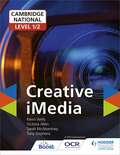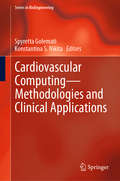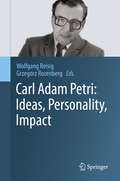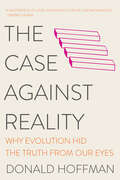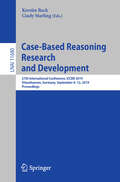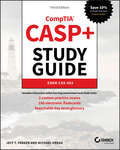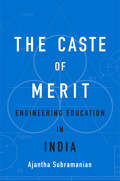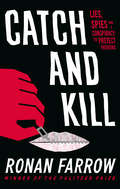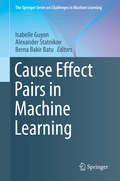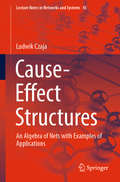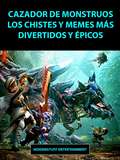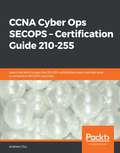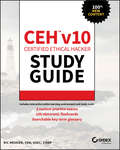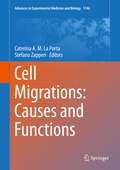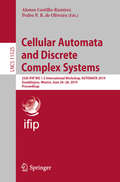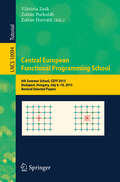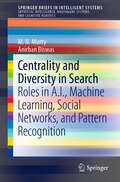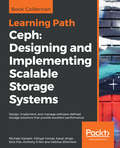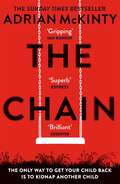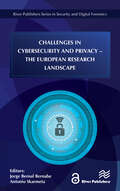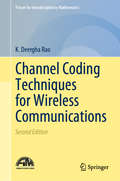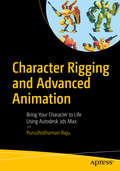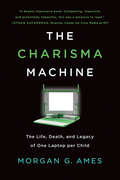- Table View
- List View
Cambridge National Level 1/2 Creative iMedia
by Kevin Wells Victoria Allen Sarah McAtominey Tony StephensStrengthen learners' grasp of the most challenging units and develop the skills required for success with this student book mapped to the Cambridge National Level 1 / 2 in Creative iMedia. Covering the mandatory and optional units, this textbook will help to build knowledge, reinforce classroom learning and test the students' understanding.· Builds students' knowledge with clearly-focused content to aid progression and activities to assess understanding.· Prepares your students for both internal and external assessment with opportunities to test and consolidate understanding.· Support your students' progress through the course with the only textbook published for the Cambridge National Level 1 /2 in Creative iMedia.
Cambridge National Level 1/2 Creative iMedia
by Kevin Wells Victoria Allen Sarah McAtominey Tony StephensStrengthen learners' grasp of the most challenging units and develop the skills required for success with this student book mapped to the Cambridge National Level 1 / 2 in Creative iMedia. Covering the mandatory and optional units, this textbook will help to build knowledge, reinforce classroom learning and test the students' understanding.· Builds students' knowledge with clearly-focused content to aid progression and activities to assess understanding.· Prepares your students for both internal and external assessment with opportunities to test and consolidate understanding.· Support your students' progress through the course with the only textbook published for the Cambridge National Level 1 /2 in Creative iMedia.
Cardiovascular Computing—Methodologies and Clinical Applications (Series in BioEngineering)
by Spyretta Golemati Konstantina S. NikitaThis book provides a comprehensive guide to the state-of-the-art in cardiovascular computing and highlights novel directions and challenges in this constantly evolving multidisciplinary field. The topics covered span a wide range of methods and clinical applications of cardiovascular computing, including advanced technologies for the acquisition and analysis of signals and images, cardiovascular informatics, and mathematical and computational modeling.
Carl Adam Petri: Ideas, Personality, Impact
by Wolfgang Reisig Grzegorz RozenbergThis book offers an overview of the key ideas of Petri nets, how they were developed, and how they were applied in diverse applications. The chapters in the first part offer individual perspectives on the impact of Petri’s work. The second part of the book contains personal memories from researchers who collaborated with him closely, in particular they recount his unique personality. The chapters in the third part offer more conventional treatments on various aspects of current Petri net research, and the fourth part examines the wide applications of Petri nets, and the relationships with other domains.The editors and authors are the leading researchers in this domain, and this book will be a valuable insight for researchers in computer science, particularly those engaged with concurrency and distributed systems.
The Case Against Reality: Why Evolution Hid The Truth From Our Eyes
by Donald HoffmanCan we trust our senses to tell us the truth? Challenging leading scientific theories that claim that our senses report back objective reality, cognitive scientist Donald Hoffman argues that while we should take our perceptions seriously, we should not take them literally. How can it be possible that the world we see is not objective reality? And how can our senses be useful if they are not communicating the truth? Hoffman grapples with these questions and more over the course of this eye-opening work. Ever since Homo sapiens has walked the earth, natural selection has favored perception that hides the truth and guides us toward useful action, shaping our senses to keep us alive and reproducing. We observe a speeding car and do not walk in front of it; we see mold growing on bread and do not eat it. These impressions, though, are not objective reality. Just like a file icon on a desktop screen is a useful symbol rather than a genuine representation of what a computer file looks like, the objects we see every day are merely icons, allowing us to navigate the world safely and with ease. The real-world implications for this discovery are huge. From examining why fashion designers create clothes that give the illusion of a more “attractive” body shape to studying how companies use color to elicit specific emotions in consumers, and even dismantling the very notion that spacetime is objective reality, The Case Against Reality dares us to question everything we thought we knew about the world we see.
Case-Based Reasoning Research and Development: 27th International Conference, ICCBR 2019, Otzenhausen, Germany, September 8–12, 2019, Proceedings (Lecture Notes in Computer Science #11680)
by Kerstin Bach Cindy MarlingThis book constitutes the refereed proceedings of the 27th International Conference on Case-Based Reasoning Research and Development, ICCBR 2019, held in Otzenhausen, Germany, in September 2019. The 26 full papers presented in this book were carefully reviewed and selected from 43 submissions. 15 were selected for oral presentation and 11 for poster presentation. The theme of ICCBR 2019, "Explainable AI (XAI)," was highlighted by several activities. These papers, which are included in the proceedings, address many themes related to the theory and application of case-based reasoning and its future direction.
CASP+ CompTIA Advanced Security Practitioner Study Guide: Exam CAS-003
by Jeff T. Parker Michael GreggComprehensive coverage of the new CASP+ exam, with hands-on practice and interactive study tools The CASP+ CompTIA Advanced Security Practitioner Study Guide: Exam CAS-003, Third Edition, offers invaluable preparation for exam CAS-003. Covering 100 percent of the exam objectives, this book provides expert walk-through of essential security concepts and processes to help you tackle this challenging exam with full confidence. Practical examples and real-world insights illustrate critical topics and show what essential practices look like on the ground, while detailed explanations of technical and business concepts give you the background you need to apply identify and implement appropriate security solutions. End-of-chapter reviews help solidify your understanding of each objective, and cutting-edge exam prep software features electronic flashcards, hands-on lab exercises, and hundreds of practice questions to help you test your knowledge in advance of the exam. The next few years will bring a 45-fold increase in digital data, and at least one third of that data will pass through the cloud. The level of risk to data everywhere is growing in parallel, and organizations are in need of qualified data security professionals; the CASP+ certification validates this in-demand skill set, and this book is your ideal resource for passing the exam. Master cryptography, controls, vulnerability analysis, and network security Identify risks and execute mitigation planning, strategies, and controls Analyze security trends and their impact on your organization Integrate business and technical components to achieve a secure enterprise architecture CASP+ meets the ISO 17024 standard, and is approved by U.S. Department of Defense to fulfill Directive 8570.01-M requirements. It is also compliant with government regulations under the Federal Information Security Management Act (FISMA). As such, this career-building credential makes you in demand in the marketplace and shows that you are qualified to address enterprise-level security concerns. The CASP+ CompTIA Advanced Security Practitioner Study Guide: Exam CAS-003, Third Edition, is the preparation resource you need to take the next big step for your career and pass with flying colors.
The Caste of Merit: Engineering Education in India
by Ajantha SubramanianJust as Americans least disadvantaged by racism are most likely to call their country post‐racial, Indians who have benefited from upper-caste affiliation rush to declare their country a post‐caste meritocracy. Ajantha Subramanian challenges this belief, showing how the ideal of meritocracy serves the reproduction of inequality in Indian education.
Catch and Kill: Lies, Spies and a Conspiracy to Protect Predators
by Ronan FarrowTHE NEW YORK TIMES BESTSELLER 'Riveting and often shocking' Sunday Times 'Dripping with jaw-dropping revelations' Telegraph'Absorbing' New York Times In a dramatic account of violence and espionage, Pulitzer Prize-winning investigative reporter Ronan Farrow exposes serial abusers and a cabal of powerful interests hell-bent on covering up the truth, at any cost.In 2017, a routine network television investigation led Ronan Farrow to a story only whispered about: one of Hollywood's most powerful producers was a predator, protected by fear, wealth and a conspiracy of silence. As Farrow drew closer to the truth, shadowy operatives, from high-priced lawyers to elite war-hardened spies, mounted a secret campaign of intimidation, threatening his career, following his every move and weaponizing an account of abuse in his own family. All the while, Farrow and his producer faced a degree of resistance that could not be explained - until now. And a trail of clues revealed corruption and cover-ups from Hollywood, to Washington and beyond. This is the untold story of the tactics of surveillance and intimidation deployed by wealthy and connected men to threaten journalists, evade accountability and silence victims of abuse - and it's the story of the women who risked everything to expose the truth and spark a global movement.'Darkly funny and poignant . . . a breathtakingly dogged piece of reporting' Guardian 'Reads like a thriller' The Cut 'Meticulous and devastating' Associated Press
Cause Effect Pairs in Machine Learning (The Springer Series on Challenges in Machine Learning)
by Isabelle Guyon Alexander Statnikov Berna Bakir BatuThis book presents ground-breaking advances in the domain of causal structure learning. The problem of distinguishing cause from effect (“Does altitude cause a change in atmospheric pressure, or vice versa?”) is here cast as a binary classification problem, to be tackled by machine learning algorithms. Based on the results of the ChaLearn Cause-Effect Pairs Challenge, this book reveals that the joint distribution of two variables can be scrutinized by machine learning algorithms to reveal the possible existence of a “causal mechanism”, in the sense that the values of one variable may have been generated from the values of the other. This book provides both tutorial material on the state-of-the-art on cause-effect pairs and exposes the reader to more advanced material, with a collection of selected papers. Supplemental material includes videos, slides, and code which can be found on the workshop website.Discovering causal relationships from observational data will become increasingly important in data science with the increasing amount of available data, as a means of detecting potential triggers in epidemiology, social sciences, economy, biology, medicine, and other sciences.
Cause-Effect Structures: An Algebra of Nets with Examples of Applications (Lecture Notes in Networks and Systems #45)
by Ludwik CzajaThis book presents a new algebraic system whose interpretation coincides with the behaviour of Petri nets, enhanced with an inhibitory mechanism and four time models. Its goal is to provide a formal means of modelling dynamic tasks, and of testing and verifying properties, in contexts characterised by the parallel execution of actions. However, the task description differs from that of Petri nets. The algebra is a quasi-semiring, “quasi” because of its somewhat restricted distributivity axiom. Expressions of this algebra, the cause–effect structures, have a graphic presentation as nets, but with one kind of named nodes, each annotated by two expressions that specify the type of signal reception from predecessors and transmission to successors. Many structural and behavioural properties are stated with proofs, and illustrative sample tasks are included. The book is intended for all those interested or involved in parallel and distributed computing – students, researchers and practitioners alike.
Cazador de Monstruos Los Chistes y Memes más Divertidos y Épicos
by Joke FactoryVas a descubrir las bromas más divertidas de Cazadores de Monstruos. Este libro está lleno de algunas de las bromas más divertidas de Cazadores de Monstruos. ¡Descubra los temas más populares de Monster Hunter Corporation junto con tontos, ridículos y simplemente divertidos chistes y memes sobre ellos! ¡Desacargue su copia instantáneamente! ¡Comparalo hoy y descubre los chistes más populares para Cazador de Monstruos!
CCNA Cyber Ops SECOPS – Certification Guide 210-255: Learn the skills to pass the 210-255 certification exam and become a competent SECOPS associate
by Andrew ChuDevelop your cybersecurity knowledge to obtain CCNA Cyber Ops certification and gain professional skills to identify and remove potential threats Key Features Explore different security analysis tools and develop your knowledge to confidently pass the 210-255 SECOPS exam Grasp real-world cybersecurity skills such as threat analysis, event correlation, and identifying malicious activity Learn through mock tests, useful tips, and up-to-date exam questions Book Description Cybersecurity roles have grown exponentially in the IT industry and an increasing number of organizations have set up security operations centers (SOCs) to monitor and respond to security threats. The 210-255 SECOPS exam is the second of two exams required for the Cisco CCNA Cyber Ops certification. By providing you with fundamental knowledge of SOC events, this certification validates your skills in managing cybersecurity processes such as analyzing threats and malicious activities, conducting security investigations, and using incident playbooks. You'll start by understanding threat analysis and computer forensics, which will help you build the foundation for learning intrusion analysis and incident response principles. The book will then guide you through vocabulary and techniques for analyzing data from the network and previous events. In later chapters, you'll discover how to identify, analyze, correlate, and respond to incidents, including how to communicate technical and inaccessible (non-technical) examples. You'll be able to build on your knowledge as you learn through examples and practice questions, and finally test your knowledge with two mock exams that allow you to put what you've learned to the test. By the end of this book, you'll have the skills to confidently pass the SECOPS 210-255 exam and achieve CCNA Cyber Ops certification. What you will learn Get up to speed with the principles of threat analysis, in a network and on a host device Understand the impact of computer forensics Examine typical and atypical network data to identify intrusions Identify the role of the SOC, and explore other individual roles in incident response Analyze data and events using common frameworks Learn the phases of an incident, and how incident response priorities change for each phase Who this book is for This book is for anyone who wants to prepare for the Cisco 210-255 SECOPS exam (CCNA Cyber Ops). If you're interested in cybersecurity, have already completed cybersecurity training as part of your formal education, or you work in Cyber Ops and just need a new certification, this book is for you. The certification guide looks at cyber operations from the ground up, consolidating concepts you may or may not have heard about before, to help you become a better cybersecurity operator.
CEH v10 Certified Ethical Hacker Study Guide
by Ric MessierAs protecting information becomes a rapidly growing concern for today’s businesses, certifications in IT security have become highly desirable, even as the number of certifications has grown. Now you can set yourself apart with the Certified Ethical Hacker (CEH v10) certification. The CEH v10 Certified Ethical Hacker Study Guide offers a comprehensive overview of the CEH certification requirements using concise and easy-to-follow instruction. Chapters are organized by exam objective, with a handy section that maps each objective to its corresponding chapter, so you can keep track of your progress. The text provides thorough coverage of all topics, along with challenging chapter review questions and Exam Essentials, a key feature that identifies critical study areas. Subjects include intrusion detection, DDoS attacks, buffer overflows, virus creation, and more. This study guide goes beyond test prep, providing practical hands-on exercises to reinforce vital skills and real-world scenarios that put what you’ve learned into the context of actual job roles. Gain a unique certification that allows you to understand the mind of a hacker Expand your career opportunities with an IT certificate that satisfies the Department of Defense’s 8570 Directive for Information Assurance positions Fully updated for the 2018 CEH v10 exam, including the latest developments in IT security Access the Sybex online learning center, with chapter review questions, full-length practice exams, hundreds of electronic flashcards, and a glossary of key terms Thanks to its clear organization, all-inclusive coverage, and practical instruction, the CEH v10 Certified Ethical Hacker Study Guide is an excellent resource for anyone who needs to understand the hacking process or anyone who wants to demonstrate their skills as a Certified Ethical Hacker.
Cell Migrations: Causes and Functions (Advances in Experimental Medicine and Biology #1146)
by Caterina A. M. La Porta Stefano ZapperiCell migration plays an important role during development and in many physiological and pathological processes, from wound healing to cancer. This edited volume presents a collection of contributions meant to illustrate the state of the art on this topic from an interdisciplinary perspective.Readers will find a detailed discussion of the properties of individual and collective cell migration, including the associated biochemical regulation and important biophysical and biomechanical aspects. The book includes information on the latest experimental techniques employed to study cell migration, from microfluidics to traction force microscopy, as well as the latest theoretical and computational models used to interpret the experimental data. Finally, the role of cell migration in cancer and in development is also reviewed.The contents of this work should appeal to students and researchers in biology and biophysics who want to get up to date on the latest interdisciplinary development in this broad field of research. The chapters are written in a self-contained form and can also be used as individual articles.
Cellular Automata and Discrete Complex Systems: 25th IFIP WG 1.5 International Workshop, AUTOMATA 2019, Guadalajara, Mexico, June 26–28, 2019, Proceedings (Lecture Notes in Computer Science #11525)
by Alonso Castillo-Ramirez Pedro P. B. de OliveiraThis volume constitutes the refereed proceedings of the 25th IFIP WG 1.5 International Workshop on Cellular Automata and Discrete Complex Systems, AUTOMATA 2019, held in Guadalajara, Mexico, in June 2019.The 7 regular papers presented in this book were carefully reviewed and selected from a total of 10 submissions. The topics of the conference include deal with dynamical, topological, ergodic and algebraic aspects of CA and DCS, algorithmic and complexity issues, emergent properties, formal languages, symbolic dynamics, tilings, models of parallelism and distributed systems, timing schemes, synchronous versus asynchronous models, phenomenological descriptions, scientic modeling, and practical applications.
Central European Functional Programming School: 6th Summer School, CEFP 2015, Budapest, Hungary, July 6–10, 2015, Revised Selected Papers (Lecture Notes in Computer Science #10094)
by Viktória Zsók Zoltán Porkoláb Zoltán HorváthThis volume presents the revised lecture notes of selected talks given at the 6th Central European Functional Programming School, CEFP 2015, held in July 2015, in Budapest, Hungary.The 10 revised full papers presented were carefully reviewed and selected. The lectures covered a wide range of functional programming and C++ programming subjects.
Centrality and Diversity in Search: Roles in A.I., Machine Learning, Social Networks, and Pattern Recognition (SpringerBriefs in Intelligent Systems)
by M.N. Murty Anirban BiswasThe concepts of centrality and diversity are highly important in search algorithms, and play central roles in applications of artificial intelligence (AI), machine learning (ML), social networks, and pattern recognition. This work examines the significance of centrality and diversity in representation, regression, ranking, clustering, optimization, and classification. The text is designed to be accessible to a broad readership. Requiring only a basic background in undergraduate-level mathematics, the work is suitable for senior undergraduate and graduate students, as well as researchers working in machine learning, data mining, social networks, and pattern recognition.
Ceph: Design, implement, and manage software-defined storage solutions that provide excellent performance
by Anthony D'Atri Nick Fisk Karan Singh Vikhyat Umrao Michael HackettGet to grips with the unified, highly scalable distributed storage system and learn how to design and implement it. Key Features Explore Ceph's architecture in detail Implement a Ceph cluster successfully and gain deep insights into its best practices Leverage the advanced features of Ceph, including erasure coding, tiering, and BlueStore Book Description This Learning Path takes you through the basics of Ceph all the way to gaining in-depth understanding of its advanced features. You'll gather skills to plan, deploy, and manage your Ceph cluster. After an introduction to the Ceph architecture and its core projects, you'll be able to set up a Ceph cluster and learn how to monitor its health, improve its performance, and troubleshoot any issues. By following the step-by-step approach of this Learning Path, you'll learn how Ceph integrates with OpenStack, Glance, Manila, Swift, and Cinder. With knowledge of federated architecture and CephFS, you'll use Calamari and VSM to monitor the Ceph environment. In the upcoming chapters, you'll study the key areas of Ceph, including BlueStore, erasure coding, and cache tiering. More specifically, you'll discover what they can do for your storage system. In the concluding chapters, you will develop applications that use Librados and distributed computations with shared object classes, and see how Ceph and its supporting infrastructure can be optimized. By the end of this Learning Path, you'll have the practical knowledge of operating Ceph in a production environment. This Learning Path includes content from the following Packt products: Ceph Cookbook by Michael Hackett, Vikhyat Umrao and Karan Singh Mastering Ceph by Nick Fisk Learning Ceph, Second Edition by Anthony D'Atri, Vaibhav Bhembre and Karan Singh What you will learn Understand the benefits of using Ceph as a storage solution Combine Ceph with OpenStack, Cinder, Glance, and Nova components Set up a test cluster with Ansible and virtual machine with VirtualBox Develop solutions with Librados and shared object classes Configure BlueStore and see its interaction with other configurations Tune, monitor, and recover storage systems effectively Build an erasure-coded pool by selecting intelligent parameters Who this book is for If you are a developer, system administrator, storage professional, or cloud engineer who wants to understand how to deploy a Ceph cluster, this Learning Path is ideal for you. It will help you discover ways in which Ceph features can solve your data storage problems. Basic knowledge of storage systems and GNU/Linux will be beneficial.
The Chain: The Award-Winning Suspense Thriller of the Year
by Adrian McKintyTHE ONLY WAY TO GET YOUR CHILD BACK IS TO KIDNAP ANOTHER CHILD'A blazing, full-tilt thriller that entirely justifies the hype' GUARDIAN'A heart-stopping roller coaster' DAILY MAIL* * * * *YOUR PHONE RINGS.A STRANGER HAS KIDNAPPED YOUR CHILD.TO FREE THEM YOU MUST ABDUCT SOMEONE ELSE'S CHILD.YOUR CHILD WILL BE RELEASED WHEN YOUR VICTIM'S PARENTS KIDNAP ANOTHER CHILD.IF ANY OF THESE THINGS DON'T HAPPEN:YOUR CHILD WILL BE KILLED.VICTIM. SURVIVOR. ABDUCTOR. CRIMINAL.YOU WILL BECOME EACH ONE. YOU ARE NOW PART OF THE CHAIN * * * * *THE MULTI-AWARD-WINNING THRILLERWinner: Theakstons Old Peculier Crime Novel of the YearWinner: Ned Kelly Award for Best International Crime Fiction Winner: International Thriller Writers Awards - Best Hardcover Winner: Macavity Awards - Best International Crime Fiction Winner: Barry Award - Thriller of the Year*****'A heart-stopping roller coaster'DAILY MAIL'The book everyone is talking about'MIRROR'Scary, plausible, gripping.'IAN RANKIN'You'll miss meals, sleep, and your stop on the bus - guaranteed.'VAL McDERMID'I writhed with the pain of withdrawal when I finished it. Deserves to be the popular hit of the year.'DAILY TELEGRAPH'Incredibly propulsive and original. You won't shake it for a long time.'STEPHEN KING'A masterpiece. You will never be able to forget it.'DON WINSLOW'A unique and unforgettable thriller. Breath-taking, breakneck, brilliant.'MARK BILLINGHAM'Striking, memorable, should be savoured.'TANA FRENCH'Explosively brilliant. Genuinely unputdownable. Terribly plausible'OBSERVER'I may not read a better thriller in my lifetime.'STEVE CAVANAGH 'An electrifying thriller - one of the very best of its kind'FIONA CUMMINS'What a fantastic idea and perfectly written. I'm quite jealous.'ANTHONY HOROWITZ'Terrifying. Terrific.'MICK HERRON'THE CHAIN does for parenting what Gone Girl did for marriage. A must-read thriller.'JAMES SWALLOW'Diabolical, unnerving, relentless.'DENNIS LEHANE'Utterly brilliant'ELLY GRIFFITHSA 'THRILLER OF THE YEAR' SELECTION FOR:GUARDIANDAILY TELEGRAPHAMAZONEXPRESSOBSERVERTIME MAGAZINE
Challenges in Cybersecurity and Privacy - the European Research Landscape
by Jorge Bernal Bernabe Antonio SkarmetaCybersecurity and Privacy issues are becoming an important barrier for a trusted and dependable global digital society development. Cyber-criminals are continuously shifting their cyber-attacks specially against cyber-physical systems and IoT, since they present additional vulnerabilities due to their constrained capabilities, their unattended nature and the usage of potential untrustworthiness components. Likewise, identity-theft, fraud, personal data leakages, and other related cyber-crimes are continuously evolving, causing important damages and privacy problems for European citizens in both virtual and physical scenarios.In this context, new holistic approaches, methodologies, techniques and tools are needed to cope with those issues, and mitigate cyberattacks, by employing novel cyber-situational awareness frameworks, risk analysis and modeling, threat intelligent systems, cyber-threat information sharing methods, advanced big-data analysis techniques as well as exploiting the benefits from latest technologies such as SDN/NFV and Cloud systems. In addition, novel privacy-preserving techniques, and crypto-privacy mechanisms, identity and eID management systems, trust services, and recommendations are needed to protect citizens’ privacy while keeping usability levels.The European Commission is addressing the challenge through different means, including the Horizon 2020 Research and Innovation program, thereby financing innovative projects that can cope with the increasing cyberthreat landscape. This book introduces several cybersecurity and privacy research challenges and how they are being addressed in the scope of 15 European research projects.Each chapter is dedicated to a different funded European Research project, which aims to cope with digital security and privacy aspects, risks, threats and cybersecurity issues from a different perspective. Each chapter includes the project’s overviews and objectives, the particular challenges they are covering, research achievements on security and privacy, as well as the techniques, outcomes, and evaluations accomplished in the scope of the EU project.The book is the result of a collaborative effort among relative ongoing European Research projects in the field of privacy and security as well as related cybersecurity fields, and it is intended to explain how these projects meet the main cybersecurity and privacy challenges faced in Europe. Namely, the EU projects analyzed in the book are: ANASTACIA, SAINT, YAKSHA, FORTIKA, CYBECO, SISSDEN, CIPSEC, CS-AWARE. RED-Alert, Truessec.eu. ARIES, LIGHTest, CREDENTIAL, FutureTrust, LEPS. Challenges in Cybersecurity and Privacy - the European Research Landscape is ideal for personnel in computer/communication industries as well as academic staff and master/research students in computer science and communications networks interested in learning about cyber-security and privacy aspects.
Channel Coding Techniques for Wireless Communications (Forum for Interdisciplinary Mathematics)
by K. Deergha RaoThis book discusses the latest channel coding techniques, MIMO systems, and 5G channel coding evolution. It provides a comprehensive overview of channel coding, covering modern techniques such as turbo codes, low-density parity-check (LDPC) codes, space–time coding, polar codes, LT codes, and Raptor codes as well as the traditional codes such as cyclic codes, BCH, RS codes, and convolutional codes. It also explores MIMO communications, which is an effective method for high-speed or high-reliability wireless communications. It also examines the evolution of 5G channel coding techniques. Each of the 13 chapters features numerous illustrative examples for easy understanding of the coding techniques, and MATLAB-based programs are integrated in the text to enhance readers’ grasp of the underlying theories. Further, PC-based MATLAB m-files for illustrative examples are included for students and researchers involved in advanced and current concepts of coding theory.
Character Rigging and Advanced Animation: Bring Your Character to Life Using Autodesk 3ds Max
by Purushothaman RajuGain a thorough understanding of animation and character rigging using Autodesk 3ds Max to create realistic character animations. This book is split into three modules that are subsequently divided into chapters. The first module is the foundation module: in this module you’ll cover, among other topics, the 12 cardinal principles of animation with reference to classic real-world examples and famous movies/animation shots. Using these, the further chapters explore using key frames and graph editors to obtain fluid motion in your animations. Practical examples are used to better explain which feature suits a particular scenario. The second module, called the backbone module, introduces you to deformation tools and their use for character animation. Further chapters cover driven animations, constraints posed by bones, bipeds, and the CAT tools available in 3ds Max 2019. The final module, the lifeline module, encourages you to bring your character to life by applying principles learnt in the previous modules. Here you will be guided on how to retarget animations from one character to other characters or rigs.On completing Character Rigging and Advance Animation, you will be able to create character rigs for bipeds and quadrupeds with ease, animating them with life-like motion. What You Will LearnUnderstand the 12 principles of animationSet up an animation-ready character rig from scratchMaster the deformation tools available for animation Who This Book Is ForReaders who are familiar with 3ds Max at a basic level and are looking at getting into character rigging and animation.
The Charisma Machine: The Life, Death, and Legacy of One Laptop per Child (Infrastructures)
by Morgan G. AmesA fascinating examination of technological utopianism and its complicated consequences.In The Charisma Machine, Morgan Ames chronicles the life and legacy of the One Laptop per Child project and explains why—despite its failures—the same utopian visions that inspired OLPC still motivate other projects trying to use technology to “disrupt” education and development. Announced in 2005 by MIT Media Lab cofounder Nicholas Negroponte, One Laptop per Child promised to transform the lives of children across the Global South with a small, sturdy, and cheap laptop computer, powered by a hand crank. In reality, the project fell short in many ways—starting with the hand crank, which never materialized. Yet the project remained charismatic to many who were captivated by its claims of access to educational opportunities previously out of reach. Behind its promises, OLPC, like many technology projects that make similarly grand claims, had a fundamentally flawed vision of who the computer was made for and what role technology should play in learning.Drawing on fifty years of history and a seven-month study of a model OLPC project in Paraguay, Ames reveals that the laptops were not only frustrating to use, easy to break, and hard to repair, they were designed for “technically precocious boys”—idealized younger versions of the developers themselves—rather than the children who were actually using them. The Charisma Machine offers a cautionary tale about the allure of technology hype and the problems that result when utopian dreams drive technology development.
Charming (Lorimer Real Love)
by Mette BachSeventeen-year-old Char loves music, but never considered a singing career until her singing went viral online. Now instead of participating in the Gay Lesbian Alliance, Char devotes herself to seeking fame. When she is viciously bullied online she finds an app that supports victims of cyber-bullying. Naming herself @Charming, Char gets to know the app's creator, @Cinders. @Cinders inspires Char to reconsider her obsession with online fame. When @Cinders turns out to be Ash, a girl at Char's school, Char must show Ash how much she means to her. Charming is a modern retelling of Cinderella, where Prince Charming is a girl who learns the nature of fame and love. Distributed in the U.S by Lerner Publishing Group
